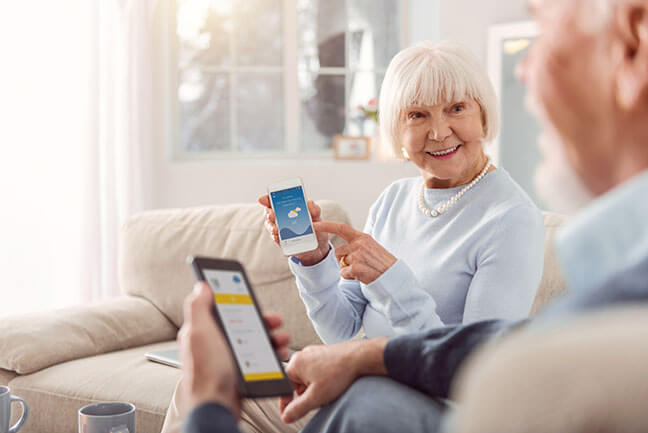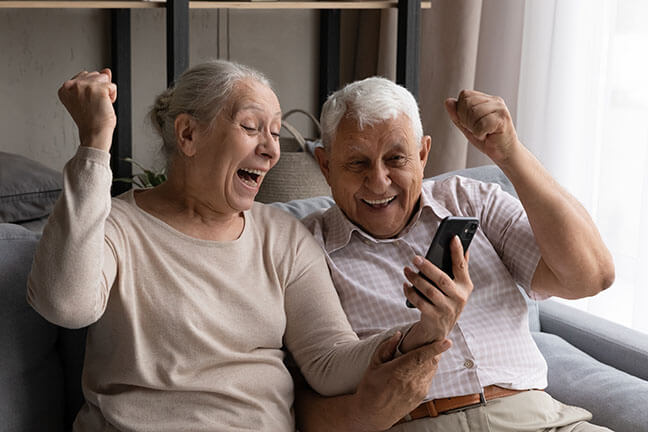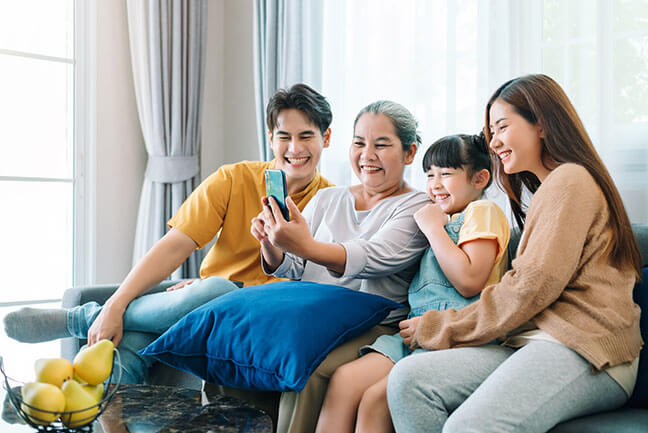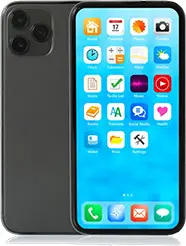With their income stopped, people in retirement often look for ways to cut down on daily expenses. And one increasingly common suggestion given to them is to exchange their expensive smartphone contract for an affordable prepaid phone plan. But while this can potentially save them hundreds of dollars, choosing a prepaid phone plan as a senior can be tricky since networks and offers seem to change every other week.
If you belong to this group, you have come to the right place. In this guide there are tips on finding plans on prepaid phones for seniors that come with the most important features and benefits. They will allow you to call your grandkids, friends, and doctors without breaking the bank. We will show you how much you can expect to pay, and even how you can qualify for a free data plan or even a free smartphone!

How Prepaid Phones Work
First let’s talk about what a prepaid phone is and how it works. Prepaid plans are typically easy-to-use and set up. But to make the process even simpler, here is how to buy and use a prepaid phone plan:
Choose a Plan And Add Money
Select one of the prepaid plans offered by your carrier and add money to your account to activate your service. This can typically be done on the carrier’s website, over the phone, or in person at a carrier store. Adding money, also known as “recharging” or “refilling” your account, can be done with a credit/debit card, cash, or mobile check deposit.
Activate Your New Phone
Once your account has money in it, you’ll need to activate your prepaid phone. This is usually as simple as turning on your phone for the first time. You may be prompted to enter some information like your zip code, the last four digits of your social security number, and your birthday to verify your identity. Your phone number will then be assigned and your service activated.
Add Additional Minutes or Data (Optional)
If needed, you can easily add more minutes, texts or data to your plan at any time to avoid service interruption. This can be done using the carrier’s mobile app, website, over the phone, or at a retail location. Additional minutes and data are added to your existing amount and do not expire as long as you continue to recharge your account regularly.
Recharge Your Account
To keep your service active, you’ll need to continue recharging your account before your plan expires or balance reaches zero. If your account balance depletes completely, your service will be disconnected. Be sure to recharge at least a few days before your plan end date to avoid any lapse in service. Most cell phone carriers will send you alerts when your balance is low, but it’s a good idea to set calendar reminders for yourself as well.

Why Prepaid Phones Are Great for Seniors
Prepaid phone plans are perfect for seniors for so many reasons. First, there are no long-term contracts to sign so you’re not locked in, meaning that you can pay as you go and change your plan anytime without penalty.
Second, prepaid plans have simple, straightforward pricing. You know exactly how many minutes, texts and data you’re getting and how much you’re paying upfront. Most plans let you carry over unused minutes and data to the next month as well.
Another perk is that a lot of plans use the T-mobile network or Verizon network to offer nationwide and high-speed coverage, so you can call friends and family across the country without worrying about roaming charges. Many plans also include free calls to Mexico and Canada.
Lastly, prepaid phones are perfect for light or basic usage. If you mostly make calls, send a few texts and check email on occasion, prepaid cell phones or flip phones will suit you well without the expense of an unlimited data plan you won’t fully use.
How Do I Find The Best Prepaid Plan For me?
Comparing prepaid phone plans for seniors based on minutes, texts and data allowances is essential to finding the right plan. Think about how you currently use your phone and how much you may want to budget for a prepaid plan. Here are a few features you’ll want to keep in mind when choosing your plan:
Minutes
For a lot of seniors, a generous minute allowance for calls is important. Look for plans that offer at least 500 minutes per month, as some basic activities like setting up doctor appointments, calling family, or dealing with insurance companies can add up quickly. If you think you’ll go over 500 minutes, compare them to plans with unlimited talk time. Basic plans offer good value for light users with around 500 to 1,000 minutes.
Texts
Texting has become a convenient way for many seniors to stay in touch with loved ones. If you frequently send text messages, look for a plan with at least 1,000 texts included. Some carriers offer unlimited texting on all plans if you prefer not to worry about limits. Consider how often you currently text to determine an amount that will suit your needs.
Data
For many seniors, a small amount of data will do since smartphones are often used primarily for calling and texting. However, if you like to check email, browse websites, or use navigation apps, opt for at least 1 to 3 gigabytes (GB) of data per month. Streaming video and music will use much more data, so only choose a higher data allowance (3GB or more) if those activities are important to you. Compare the overage charges for going over your data limit to avoid surprise fees.

Downsides of Prepaid Phones For Seniors
Prepaid phone plans are popular with many seniors because they offer several benefits over contract plans. However, there are also some potential downsides to consider before switching to a prepaid plan. So here we list out all the downsides to help you make the best decision.
First, prepaid phones typically require you to pay full price for the phone upfront. While you can often bring your own phone, the latest models can be expensive. Prepaid plans also usually lack some of the perks of contract plans like device insurance, visual voicemail, and mobile hotspot capabilities. Customer service and network coverage may be more limited with some prepaid carriers. If you travel frequently, prepaid plans can be inconvenient since coverage and plans are not as widely available outside the U.S.
For many seniors on a budget, the pros of lower costs and flexibility outweigh the potential downsides. But if features and coverage are priorities, you may prefer a contract carrier.
Prepaid Alternatives: Affordable Plans With Unlimited Data
Many senior cell phone plans now offer unlimited data so you can stay connected to friends and family without worrying about surprise overage charges. If prepaid isn’t for you, a lot of major carriers offer affordable unlimited plans for seniors starting at around $50 to $70 per month.
Look for a plan that includes:
- Unlimited talk and text nationwide
- Mobile hotspot data so you can connect your tablet or laptop
- HD streaming for watching videos, movies and TV shows on the go
- International calling options in case you have friends or family living abroad
- No annual contract so you have flexibility to change plans or carriers if needed
Some carriers also offer extra perks for seniors like:
- Discounts on certain accessories like wireless chargers, headphones or smartwatches
- Special deals when you add additional lines for family members
- Waived activation and upgrade fees which can save you $30-$50 per line

Flip Phones vs Smartphones: Which Is Better for Seniors?
Now that we’ve covered phone plans, it’s time to look at your actual device. When choosing a phone for seniors, one of the biggest decisions is whether to go with a basic flip phone or an easy-to-use smartphone. Each has its pros and cons for older users, so you’ll want to weigh them carefully based on your needs and abilities to find the best cell phones out there.
Flip phones, also known as feature phones, are very simple to use. They have large buttons, basic functions like calling and texting, and long battery lives. However, they lack many of the useful smartphone features like navigation apps, health trackers, and staying connected to friends and family with social media or video calls.
Smartphones, on the other hand, unlock a whole world of possibilities. Models with large touchscreens and simplified interfaces can make smartphones accessible for seniors. But the downside is smartphones typically have shorter battery lives, smaller buttons, and can be more difficult to use. The wealth of options and notifications can also feel overwhelming for some.
FAQ: Common Questions From Seniors About Prepaid Phones
Many seniors have questions about prepaid cell phone plans before switching from a traditional contract plan. Here we have gathered some of the most common questions. We also try to answer them to help you choose the right prepaid phone plan for your needs.
Do prepaid plans have good coverage?
Prepaid plans use the same cell towers as major carriers, so you’ll have reliable nationwide coverage with most prepaid providers. Some prepaid brands may have additional coverage in certain areas, so check with providers that use the network from your current carrier.
Will I have data and smartphone options?
Yes, most prepaid plans offer data packages and the option to bring your own smartphone or purchase an affordable phone. Many plans offer unlimited talk and text plus some starter gigabytes of data to power a smartphone. You can also opt for a more basic plan with limited data and bring a simple flip phone.
Are there additional fees?
One of the main benefits of prepaid cell phones for seniors is the lack of surprise fees. There are no annual contracts, no overage charges, and no hidden fees. You pay in advance for the service you want, whether it’s 30 days, 90 days or longer. Some plans charge a small activation fee when you first sign up for service.
Can I keep my current phone number?
If you want to transfer your current phone number to a prepaid plan, most major carriers and retailers offer this service for free or a small fee when you sign up. Be sure to ask if number porting is available for the specific prepaid plan you’re interested in.
Are there age-related discounts?
Some prepaid brands offer senior-specific plans with features like emergency alert buttons or discounts for AARP members.
Choosing a prepaid cell phone plan tailored to your needs as a senior can provide affordable, reliable service and peace of mind. Asking questions about coverage, phones, fees and discounts will help you find a plan that keeps you connected for less.

Must-Have Phone Features for Seniors
We’ve talked about phone plans and the phones themselves. So what about all those confusing features and complex systems with your new phone? Don’t worry, there are phones designed with senior-friendly features that make calling, texting, and even web browsing a breeze. Forget about tiny buttons, confusing menus, and specs that will make your head spin. Here we list out features that a senior-friendly phone should have that will make using them a more hassle-free experience.
Large, High-Contrast Display
A big, high-contrast display is a must for senior-friendly smartphones. Look for a screen size of at least 5 to 6 inches so text is easy to read. An LCD or LED display with a high resolution will make everything sharp and crisp.
For maximum visibility, choose a phone with an adaptive display that automatically adjusts brightness based on the ambient light.
Bright screen colors that contrast well also help. Look for a phone with an easy-to-read, uncluttered interface that prominently features large icons, text, and buttons against a neutral background. Menus and submenus should have a logical layout that is intuitive to navigate.
Simple And Intuitive Interface
A simple, easy-to-use interface is essential as well. Look for clearly labeled buttons, minimal clutter, and a clean and simple display. The last thing you want is to feel overwhelmed every time you turn on your new phone.
Features like extra-large text, text-to-speech that reads menus and messages aloud, and being hearing aid compatible make smartphones much more accessible and user-friendly. Many offer “easy mode” interfaces with simplified home screens, larger icons, and bigger fonts.
To avoid confusion, choose a phone with familiar, tactile buttons, not just a touchscreen. Physical buttons to control volume, call, end call, and return to the home screen are helpful.
The most senior-friendly smartphones keep things straightforward. Minimal clutter, simple navigation, readable text, and familiar, physical buttons are must-haves. An uncluttered, simplified experience means less frustration and more independence. The right, thoughtfully designed interface can make all the difference.
Emergency Alert Button
An urgent response button is a must-have feature for senior smartphones. Look for a phone with a prominent emergency alert or “SOS” button that can quickly call emergency services or designated emergency contacts.
Emergency Alert Button
With the tap of a button, an emergency alert feature can:
- Call 911 emergency services
- Send a text message with the senior’s location to emergency contacts like family members
- Sound an audible alarm to attract attention from others nearby
This gives seniors – and their loved ones – peace of mind that help can be summoned right away in a crisis. Some phones allow emergency contacts and medical details to be preset so that information can be readily accessed during an emergency call.
For maximum coverage, choose a phone with emergency calling features that work even without an activated mobile plan or cell service. Some phones offer emergency calling over wi-fi or a mobile network, giving seniors multiple ways to connect in an emergency when every second counts.

Loud, Clear Speakerphone
A loud, clear speakerphone is also a must for seniors. Look for a smartphone with an amplified speaker that projects sound well. Many phones now advertise “HD voice” or “advanced noise cancelation” which help make calls crisper and louder. Here are some options to consider:
- Look for a minimum speaker size of 1 watt or larger. Bigger speakers generally mean better volume and sound quality.
- Choose a model with an adjustable volume booster or “super loud” mode. This allows you to increase the maximum volume for calls and alerts beyond the normal level.
- Consider a smartphone with hearing aid compatibility. Phones with ratings of M3 or higher are optimized to work with most hearing aids and cochlear implants, reducing interference and improving sound quality during calls.
- Explore additional accessories like amplified phone stands, large button phone pads, and wireless headsets. These can further enhance speaker volume and make smartphones more accessible and easier to use for senior citizens or anyone with hearing difficulties. With the right combination of phone features and accessories, staying connected is a breeze.
Easy-to-Use Keyboard
A large, well-spaced keyboard is essential for senior citizens. Look for a phone with separated, physical keys that provide tactile feedback when pressed. Virtual keyboards on touchscreens can be difficult to use for those with limited dexterity or vision.
Large, Physical Keys
Physical keys that are widely spaced apart are much easier to press than tiny touchscreen keys or a keyboard cramped onto a small screen. Larger keys also make it easier to see the letters, numbers and symbols.
A keyboard optimized for seniors can make a world of difference in usability and help keep you connected. When shopping for a new phone, be sure to consider keyboard size and style—not just screen size or system.
Basic Camera for Sharing Photos
A basic camera feature is a great feature for seniors who want to stay connected with friends and family. Look for a smartphone with at least an 8MP rear-facing camera so you can capture and share casual photos.
Easy to Use Camera App
Look for a simple camera interface with large buttons for key functions like zoom, flash, timer and different modes like photo, video or panorama. Some options may include “auto” settings so you don’t have to adjust exposure, white balance, or focus it manually. The ability to review, edit and share photos right from the camera app is also useful.
Once you’ve taken photos, sharing them with loved ones on social media or via text and email is a great way to stay in touch when you can’t see each other in person. If needed, many smartphones offer accessibility features like voice control, magnification or screen readers to help operate the camera. Don’t let technology limitations stop you from capturing and sharing meaningful moments.
Long Battery Life and Charging Dock
A long-lasting battery and charging dock are great features for seniors. Look for a phone with at least a 3,000 mAh battery, which should provide 6-7 hours of active use per charge. Some phones even offer up to 5,000 mAh batteries that can last 12 hours or more between charges.
Having a charging dock or wireless charging pad allows convenient charging without dealing with cords. Simply place the phone on the dock or pad and it will charge on its own. Some docks also function as a stand, propping up the phone so notifications and calls are visible at a glance.
For those on the go, a portable charger or power bank provides backup power in case the phone battery starts running low. Look for a charger with at least a 5,000 mAh capacity, which can provide up to two full phone charges before needing to be recharged itself. The charger plugs into any standard wall outlet to recharge and is small enough to go in a pocket or purse.

How About a FREE PHONE and UNLIMITED DATA For Seniors??
If you’ve made it this far into our blog, you’re probably in the market for your next phone plan but perhaps are still unsure of what to purchase. Or maybe you are reviewing features, comparing benefits, and checking prices and discounts.. Well let us save you the trouble!
At EASY Wireless, seniors on a budget or fixed-income can qualify for incredible benefits, including a FREE phone and FREE Data plan. Here’s how:
Lifeline/ACP Programs with EASY Wireless.
Lifeline and the Affordable Connectivity Program (ACP) are government programs designed to make phone and internet services more affordable for eligible low-income seniors and families. At EASY Wireless, we understand how important affordable connectivity is for seniors, and we want to help you access the benefits of these programs so that you can stay connected without breaking the bank!
What Benefits Do I Get With EASY Wireless?
Upon enrolling in one of the programs above, you can receive EASY Wireless benefits such as:
EASY Wireless Unlimited Plan
- FREE Unlimited Data
- FREE Unlimited Talk
- FREE Unlimited Text
- FREE Brand-new Smartphone
- FREE SIM Card Kit and Activation
- Choose to Keep Your Number or Get a New One
How do I Apply For EASY Wireless Benefits?
When you come to one of EASY Wireless’s retail stores, our customer service agent will help you apply for the benefits.
The first step is to provide proof of identity with a government-issued ID. This is so you can confirm your participation in one of the qualifying programs or that you meet the household income requirement.
We accept the following U.S. Government Issued ID:
- U.S. Driver’s License
- Certificate of U.S. Citizenship
- Certificate of Naturalization
- U.S. Passport
- U.S. Government, State or Tribal issued-ID
- U.S. Military ID cards
- Permanent Resident Cards
- Permanent Resident Alien Cards
You can show the following documents to prove that you are taking part in a government assistance program or use them as proof of active benefits:
- Statement of benefits from a qualifying Program.
- Notice letter of participation, such as an award letter
- Program participation documents, such as a screenshot from an online account.
- In order to show income, you can provide any of the following proofs:
- Unemployment Documentation
- Copy of your State or Federal income tax return.
- Three months’ worth of current pay stubs.
- Veterans Administration or SSI benefits letter.
- A divorce decree or child support document that states income.
- Retirement or pension statement.

Need More Than Just One Line of Service or an Additional Phone?
EASY Wireless is a full-service cellular store that cares about all of your connectivity needs. We have a large variety of pre-paid plans for every budget and usage requirement. Also, we offer a selection of brand-name phones that combine quality, reliability, and the latest technology.
That’s not all – we also provide an array of amazing accessories to enhance your mobile experience. At EASY Wireless, we’re dedicated to providing exceptional service and ensuring you find the perfect plan, phone, and accessories to suit your lifestyle and preferences.
Visit us for all your cell phone and wireless service needs today!
Start Saving Today!
Start Saving Today!


